If I held a crystal ball 10 years ago, I’m not sure I would’ve believed it if it showed me the increased interest in the ketogenic diet would look like the figure below. That’s 2 logs, folks.
Admittedly, I started my journey on this path in 2009, with a deep dive into ketosis in the Spring of 2011, but it seemed so obscure! (For a timeline of what I did, I think I covered it somewhere in this talk…yes I’m too lazy to actually confirm this by skimming through it.) All told I spent approximately 3 years in the strictest state of nutritional ketosis (NK) with one very memorable deviation when I had 6 or 7 full-sized and upsettingly decadent desserts circa September 2013. I believe the diet helped me transition from metabolic syndrome to metabolic health and I certainly thought it could benefit other people. This nutritional state could gain some steam, I thought.
I was well aware of the dearth of mainstream knowledge of NK, and particularly the conflation of NK with diabetic ketoacidosis (DKA), a pathologic state that results from the complete or near absence of insulin, which is what prompted my writing and desire to share my journey. And I was once in the wanker category of folks who spoke with “authority” about ketosis, despite knowing somewhere between zero and nothing on the topic. I remember exactly where I was sitting in a clinic at Johns Hopkins in 2002 during my residency explaining to (admonishing, really) a patient who was on the Atkins diet how harmful it was because of DKA. Not only that, the ketogenic diet could be seen as the antithesis of a “healthy” diet by conventional standards. I could see how this was a difficult proposition for many to acknowledge.
The beautiful part of good science is its self-correcting nature. The ugly part is this self-correcting nature often moves at a glacial pace—and it’s not linear. We often view history century-by-century and see what amounts to continual progress in medicine. But we live our lives—and consume information—day-by-day, exposed to the peaks and valleys of medical wisdom.
Looking back on my earlier posts on ketosis—and explaining what I eat, for example—makes me both chuckle and cringe. I remember how bizarre the diet seemed to many readers and the general public at the time. I also remember digging into the literature and learning, for example, that my alma mater, Johns Hopkins had been using the ketogenic diet to treat pediatric epilepsy for almost a century…and being so embarrassed about admonishing that patient I saw in my residency.
Since then, it’s safe to say I dove down the rabbit hole. The more I learned, the more I grew tired of reading so much misinformation on the topic. While there are more thoughtful people and articles on the subject of ketosis these days (e.g., here’s a thoughtful video on ketosis and ketogenic diets from one of my most important ketosis mentors, Steve Phinney, a co-founder of Virta Health1Disclosure: I’m an investor in, and advisor to, Virta Health.), there are still pieces like the one Vox published this month, that doesn’t exactly do the topic justice.
Like many variables in diet, health, and disease, it behooves us to look beyond the bumper sticker explanation. I want to highlight a couple of posts I wrote, to attempt to provide a little more nuance and understanding to the subject: “Ketosis — advantaged or misunderstood state?” Parts I and II. Part I follows below. I’m hoping to write more on the topic in the not-too-distant future since there’s been a number of intriguing papers published recently (certainly since 2012). But I also wanted to bring these back into focus in light of the information I’m seeing more of on the interwebz. (You can also visit the Ketosis section of the site to view more articles on the subject.)
Because I know people will ask, I have not been on a ketogenic diet “regularly” since about mid- to late-2014. The reasons are too nuanced to describe here, but my deviation is not because I lost confidence in its efficacy. With nearly a decade of clinical experience, I can safely say I was an outlier (in the best sense) with respect to my physiology and response. I was leaner, and more mentally and physically fit during this three year period than during any other period of time as an adult, and my biomarkers were as good as they had ever been. I’ve also seen the benefit of ketogenic diets first-hand on my patients and my own sister, a remarkable story I hope to share one day. But I’ve also been humbled by my inability to explain why some people have suboptimal or even negative responses to NK. I would say, all things considered, my knowledge of ketosis is greater today than when I was writing about it voraciously, but my confidence in my understanding of it, might actually be lower. As the saying goes, the further one goes from shore, the deeper the water gets.
—P.A., April 2018
§
(Part I: originally posted November 26, 2012)
In part I of this post I will see to it (assuming you read it) that you’ll know more about ketosis than just about anyone, including your doctor or the majority of “experts” out there writing about this topic.
Before we begin, a disclaimer in order: If you want to actually understand this topic, you must invest the time and mental energy to do so. You really have to get into the details. Obviously, I love the details and probably read 5 or 6 scientific papers every week on this topic (and others). I don’t expect the casual reader to want to do this, and I view it as my role to synthesize this information and present it to you. But this is not a bumper-sticker issue. I know it’s trendy to make blanket statements – ketosis is “unnatural,” for example, or ketosis is “superior” – but such statements mean nothing if you don’t understand the biochemistry and evolution of our species. So, let’s agree to let the unsubstantiated statements and bumper stickers reside in the world of political debates and opinion-based discussions. For this reason, I’ve deliberately broken this post down and only included this content (i.e., background) for Part I.
What is ketosis?
Ketosis is a metabolic state in which the liver produces small organic molecules called ketone bodies at “sufficient” levels, which I’ll expand upon later. First, let’s get the semantics correct. The first confusing thing about ketosis is that ketone bodies are not all – technically — ketones, whose structure is shown below. Technically, the term ketone denotes an organic molecule where a carbon atom, sandwiched between 2 other carbon atoms (denoted by R and R’), is double-bonded to an oxygen atom.
Conversely, the term “ketone bodies” refers to 3 very specific molecules: acetone, acetoacetone (or acetoacetic acid), and beta-hydroxybutyrate (or beta-hydroxybutyric acid), shown below, of which only 2 are technically ketones. (The reason beta-hydroxybutyrate, or B-OHB, is not technically a ketone is that the carbon double-bonded to the oxygen is bonded to an –OH group on one side, technically making B-OHB a carboxylic acid for anyone keeping score.)
Now, back to the real question at hand. Why would our body make these substances? To understand why or when the body would do this requires some understanding of how the body converts stored energy (the food we eat or the energy we store in our body, i.e., fat or glycogen) into phosphate donors. For a refresher on this process, please refer to the video in this post, specifically the section from 2:15 to 13:30.
The ATP issue
As you may recall, about 60% of the energy we expend, say 1,800 kcal/day for someone consuming 3,000 kcal/day in weight balance, is purely devoted to keeping us alive by generating enough ATP (“energy currency”) to do 2 things: allow ion gradients to function and allow muscular relaxation. So, obviously, we can’t tolerate – literally even for one minute – insufficient ATP production. In fact, one of the most potent toxins known to man (cyanide) exerts its effect on this process by inhibiting the electron transport chain which generates the bulk of the ATP our body produces. Even the most transient interruption of this process is fatal.
Take home message #1: No ATP, even for 1 minute, equals no life.
The brain issue
The brain is a particularly greedy organ when it comes to energy requirement. To put this comment in perspective consider the following: though our brain represents only about 2% of our body mass, it accounts for about 20% of our energy expenditure. (In children, by the way, this may be closer to 40-50% of basal metabolic demand.) So, beyond the ATP issue, above, there is a substrate issue with the brain as neurons derive most of their energy from glucose. While there is emerging evidence that neurons can also oxidize fatty acids directly in small amounts and may even prefer lactate (over glucose), these two substrates do not approach the levels of consumption by neurons that glucose does. So, for the purpose of this discussion, let’s just focus on the need of the body to provide glucose to the brain.
You’ll recall, from the point I made above, that my brain requires about 400 to 500 kcal of glucose per day (100 to 120 gm). You’ll also recall (from the video, above) that I can store about 100 to 120 gm of glucose in my liver. While I can store much more in my muscles, (on the order of about 300 to 350 gm), because muscles lack the enzyme glucose-6-phosphatase, glucose stored in muscle as glycogen is unable to re-enter the bloodstream and is meant for the muscle and the muscle alone to use. In other words, muscle glycogen is a stranded asset of glucose in the body to be used only by the muscle.
So, if I’m deprived of a dietary source of glucose, I depend solely on my liver to release glycogen (a process known as hepatic glucose output, or HGO). How long can HGO supply my brain with sufficient glucose? It depends on a few things that impact both the “source” and the “sink” of glucose. Other competing sinks for glucose (e.g., activity level, thermogenic needs) and sources (e.g., glycerol and gluconeogenic amino acid availability) can make a difference for a while. But, in a state of starvation we’ve only got about one to three days before we’re in trouble. If our brain doesn’t get a hold of something else, besides glucose, we will die quite unceremoniously.
Take home message #2: No glucose for 24-72 hours equals the need for something else the brain can use instead (that is not fat or protein, since neurons can’t oxidize fat and the last thing we want to do is start muscle wasting at a geometric rate).
The Krebs Cycle
This poses a real evolutionary dilemma. We need an enormous amount of energy just to not die, but the single most important organ in our body (also quite energy hungry in its own right) can’t access the most abundant source of energy in our body (i.e., fat) and is, instead, almost solely dependent on the one macronutrient we can’t store beyond a trivial amount (i.e., glucose). Obviously our species wouldn’t be here today if this were the end of the story. But, to understand how we survived requires one more trip down biochemistry memory lane. In the figure below (also included and described in the video) I gloss over a pretty important detail.
How, exactly, does our body take pyruvate (from glucose) or acetyl CoA (from fat) and generate so much ATP? The answer lies in the beauty of the Krebs Cycle, which feeds into a process called the electron transport chain (or ETC), I alluded to above. Since the adage ‘you can’t get something for nothing’ is as true in biochemistry as it appears to be in life, to get all that ATP (i.e., stored energy in the form of the phosphate bond), we need to give up something. What the ETC does give up, as its name suggests, is electrons. Through a series of redox reactions the ETC trades the stored energy held by electrons going from higher to lower energy states in exchange for the chemical energy stored in the bonds of the third phosphate group on an ATP molecule.
To think of it another way, if you start with stored energy – glucose or fat, for example, which if burned in calorimeter will give off varying amounts of heat – and you’re willing to convert their carbon, hydrogen, and oxygen molecules into another form with less energy – water and carbon dioxide which, if burned, produce very little heat – it’s a fair trade! The ETC is simply the vehicle that allows our body to make the switch.
In a car, by contrast, it’s much simpler. The engine combusts the hydrocarbon (e.g., gasoline) directly and in one flash liberates the heat contained within the hydrogen-carbon and carbon-carbon bonds in exchange for carbon dioxide, water vapor, and a few other things.
If you take a look at the figure, below, you’ll get a sense of the moving pieces involved in this cyclic transfer process. Molecules shuffle back and forth, around the cycle, and kick off spent carbon (carbon dioxide, termed “waste”) and reducing agents (e.g., conversion from NAD+ to NADH) for the ETC.
Where do the ketones come in?
In the absence of acetyl CoA (several ways this can happen, including substrate shortage, as I’m describing here) we evolved a cool trick. Our liver can make – out of fat or protein, though we much prefer to use fat so we can spare our protein and prevent severe muscle wasting – something called beta-hydroxybutyrate, one of the 3 ketone bodies I described above.
B-OHB and acetoacetate (see figure below from this paper by Cahill and Veech, 2003) are produced by the liver from long and medium chain fatty acids and released into the bloodstream.
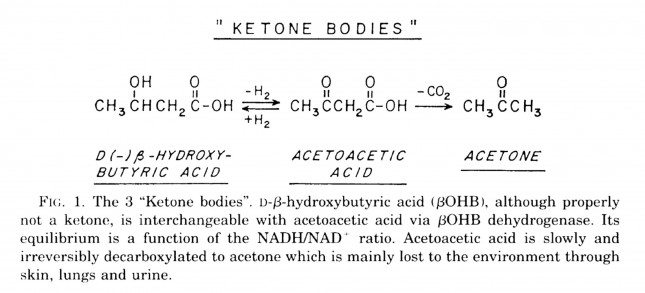
Acetoacetic acid and B-OHB live in reversible equilibrium (on the left), but once acetoacetate is converted to acetone (on the right) there’s no going back.
Now take a look at the figure below, from this 2001 paper. This is another rendition of the figure above showing the Krebs Cycle, but here you can see where B-OHB and acetoacetate enter the picture.
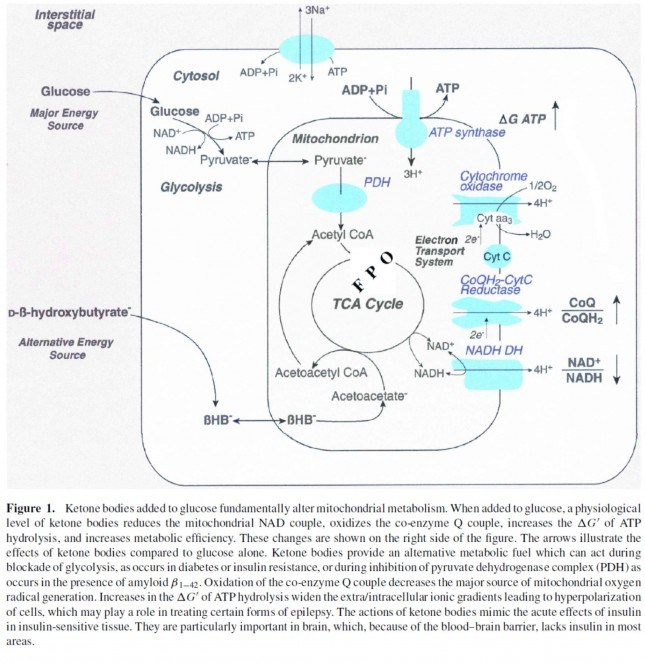
The reason a starving person can live for 40-60 days is precisely because we can turn fat into ketones and convert ketones into substrate for the Krebs Cycle in the mitochondria of our neurons. In fact, the more fat you have on your body, the longer you can survive. As an example of this, you may want to read this remarkable case report of a 382 day medically supervised fast (with only water and electrolytes)! If we had to rely on glucose, we’d die in a few days. If we could only rely on protein, we’d live a few more days but become completely debilitated with muscle wasting.
The graph below, also from the Cahill and Veech paper, shows the blood chemistry of a person starving for 40 days. Within about 3 days, a starving person’s level of glucose stops falling. Within about 10 days they reach a steady-state equilibrium with B-OHB levels exceeding glucose levels and offsetting most of the brain’s need for glucose. In fact, the late George Cahill did an experiment many years ago (probably would never get IRB approval to do such an experiment today) to demonstrate how ketones can offset glucose in the brain. Subjects with very high levels of B-OHB (about 5-7 mM) were injected with insulin until glucose levels reached 1 mM (about 19 mg/dL)! A normal person would fall into a coma at glucose levels below about 40 mg/dL and die by the time blood glucose reached 1 mM. These subjects were completely asymptomatic and 100% neurologically functional.
The last point I’ll make on the starving patient is that, as you can see in the figure below, the glucose level normalizes at about 65-70 mg/dL (about 3.7 mM) within days of fasting, despite no sources of exogenous glucose. Why? Because with so much fat being converted into B-OHB and acetoacetic acid by the liver, a significant amount of glycerol (the 3-carbon backbone of triglycerides) is liberated and converted by the liver into glycogen. As an aside, this is why someone in nutritional ketosis – even if eating zero carbohydrates – still has about 50-70% of a normal glycogen level, as demonstrated by muscle biopsies in such subjects.
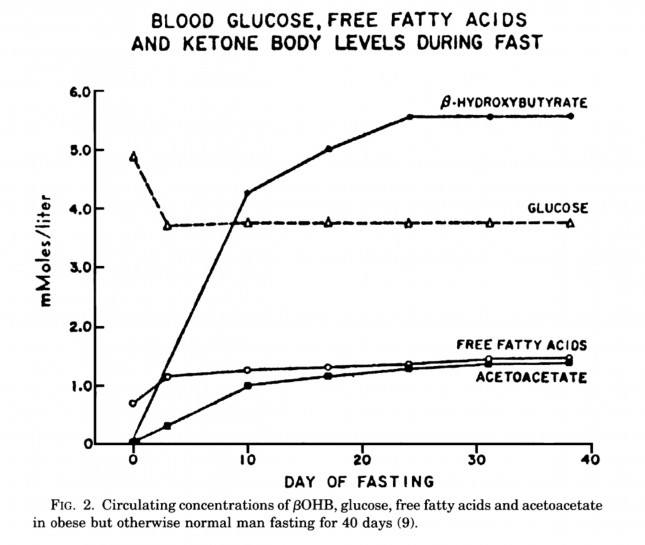
Take home message #3: We evolved to produce ketone bodies so we could not only tolerate but also thrive in the absence of glucose for prolonged periods of time. No ability to produce ketone bodies = no human species.
Last point of background: Everything I’ve just presented is based on data from starving subjects. If one restricts carbohydrate intake, typically to less than about 20-50 gm/day (dependent on timing and carbohydrate composition), and maintains modest but not high protein intake (because protein is gluconeogenic – i.e., protein in excess will be converted to glycogen by the liver), one can induce a state referred to as “nutritional ketosis” with similar physiology to what I’ve just presented without resorting to starvation. Why you’d do this is something I will discuss later.
One other housekeeping issue: Ketosis versus DKA?
In a separate post, I explained the difference between nutritional ketosis (NK) and diabetic ketoacidosis (DKA). If this distinction is not clear, I’d suggest giving this separate post a quick skim for a refresher. DKA is a pathologic (i.e., harmful) state that results from the complete or near absence of insulin. This occurs in the setting of type 1 diabetes or very end-stage type 2 diabetes, and often as the result of a physiologic insult (e.g., an infection) where the patient is not receiving sufficient insulin to bring glucose into his cells. A person with a normal pancreas, regardless of how long he fasts (including the fellow I reference above who fasted for 382 days!) or how much he restricts carbohydrates, can not enter DKA because even a trace amount of insulin will keep B-OHB levels below about 7 or 8 mM, well below the threshold to develop the pathologic acid-base abnormalities associated with DKA. Let me reiterate, it is physiologically impossible to induce DKA in anyone that does not have T1D or very, very, very late-stage T2D with pancreatic “burnout.”
Embarrassing admission: I remember exactly where I was sitting in a clinic at Johns Hopkins in 2002 explaining to (admonishing, really) a patient who was on the Atkins diet how harmful it was because of DKA. I am so embarrassed by my complete stupidity and utter failure to pick up a single scientific article to fact check this dogma I was spewing to this poor patient. If you’re reading this, sir, please forgive me. You deserved a smarter doctor.
In Part II of this post I’ll tackle the questions I know folks still have on their mind (below). Until then, re-read this post to make sure you really understand this physiology. You’re already 10 steps ahead of the next person.
- Is there a “metabolic advantage” to being in ketosis?
- Are there dangers of being in ketosis?
- What are the most important things you need to know about getting into (or staying in) ketosis?



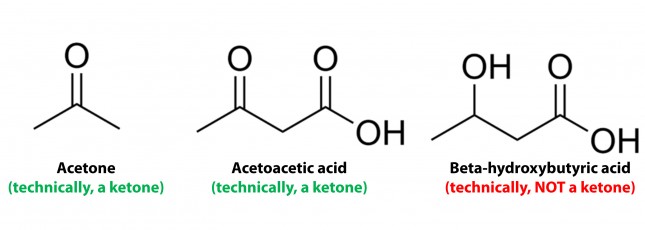
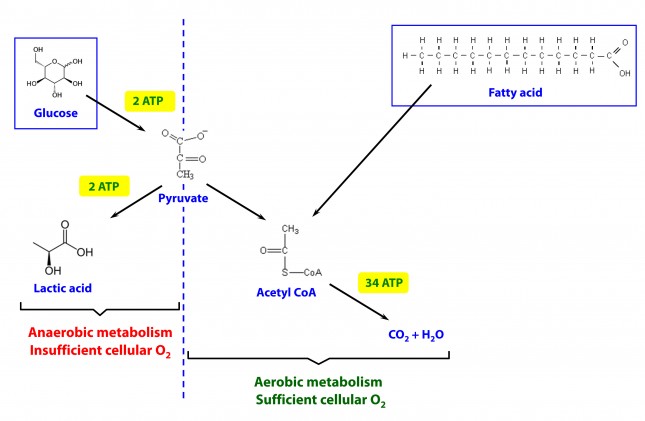
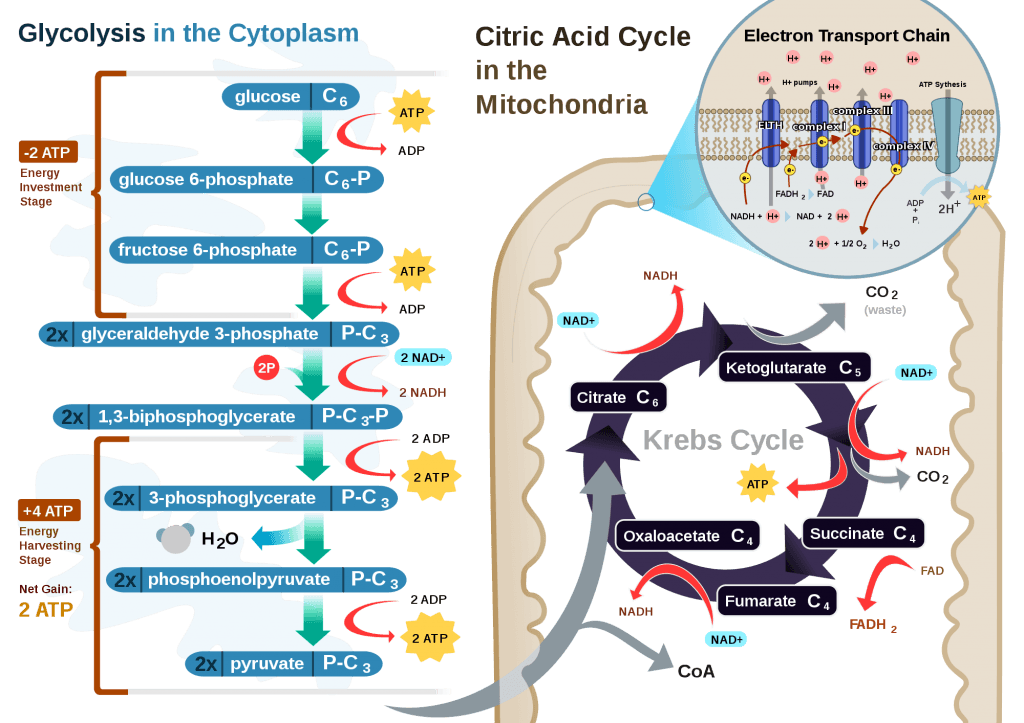
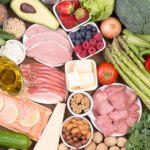



Hi Peter, by “actionable” do you mean that you agree with studies that recommend avoiding saturated fat for 3/4, 4/4? How is this compatable with low-carb? Thank you
I don’t think apoE is the right gene to give us insight into SFA. If anything, I’d look at apoCIII.
What is your approach to Apo E 3/4 and 4/4? Thank you
Very patient specific. No formula.
Hello. :)I just came across your site. Thanks so much!
I am wondering if you have heard of the K-E diet. It’s where they insert a pediatric nasal tube and you get MCT oil and a powder for 10 days. Puts you into ketosis and you lose about a pound or two a day. Is this dangerous? On the urine sticks you will get to the very dark purple the 150 for 5-8 days. Depending on the person. You take nothing by mouth except for water and chicken broth. What do you think of this? A what point would muscle wasting occur? How often do you think you could do it? Thanks so much!!
https://kediet.com/
Thanks for a fantastic and very informative article Peter. I just wanted to point out a slightly ambiguous/confusing line: “Molecules shuffle back and forth, around the cycle, and kick off spent carbon (carbon dioxide, termed “waste”) and reducing agents (e.g., conversion from NAD+ to NADH) for the ETC.”. It sounds from this as if there is a “spent reducing agent”, when really there is an oxidizing agent (NAD+) that has been “spent” and thus become a reducing agent (NADH). This is potentially quite confusing for someone new to chemistry. I’d change the wording to “kick off reducing agents (NADH, generated from the oxidizing agent NAD+) for the ETC and spent carbon (carbon dioxide, termed “waste”).”
Thanks, Sean. Will try to modify at some point.
I’m a Type 2 diabetic. I can’t get into ketosis. My liver seems determined to keep adding glucose even when my glycogen stores should have been depleted. I was eating a diet with a ketogenic ratio of over 2. My blood glucose never normalized, and after at least 10 days on this diet, my liver was still capable of raising my BG by 60+ points mg/dl from vigorous exercise. My ketostix and NovaMax meter showed that I never got to a good ketosis level. I finally stopped the diet because I was worried about what part of my body my liver was taking apart to get the raw material to make glucose. I want the benefits of ketosis. How can I control my liver? Help!
You mentioned that too much protein would prevent ketosis, wouldn’t too much protein turn into fat or be toxic, aren’t ketones created once you begin gluconeogenesis, the latter requires energy, and then most of the body then runs on ketones except the brain.Of course if your diabaetic, you will have hepatic gluconeogensis, I’m not exactly sure if metformin would then have a positive or negative effect in the blood sugar, since met rarely causes low blood sugar, does the met stop working or stop interfering with liver dumping , or does that body become very insulin resistance and dump a lot of glucose in the body?
There doesn’t seem to be a clear answer.
Protein to fat is a virtually non-existent pathway outside of massive overfeeding. True, protein “overfeeding” (i.e., beyond the amino acid requirement of the body) will result in GNG, some of which can technically result in DNL, but this is pretty small.
Hello, I’m just starting to read the information and it’s a bit overwhelming and challenging to understand. I am 50 and need to now begin taking care of myself instead of my family. I am a full time English teacher and cared for my mother in the last 5 years of her life, which was exhausting. One of my former students has lost 75 pounds and she suggested I start here by reading your article. Now where do I begin the life style change and weight loss program?
Kristin, hopefully much of the info you need is all within this blog and other place it directs to.
Kristin, from a fellow beginner: Start by watching Dr. Attia’s TEDMED talk to understand the underlying concept. Then read his journey following the “about me” link for his personal nutrition journey. You can get another overview at https://www.dietdoctor.com/lchf. While you’re working on it, read all the posts here one at a time to learn how to troubleshoot and how to find and read the science studies that will help you troubleshoot. Good luck!
Hi Peter, I am really proud of you , I came to your site yesterday accidently and was so amazed of your knowledge and way of thinking. I am type 1 diabetic and following low carb on and off until I decided to follow a under 40 low carb diet strictly and that was 4 days ago ,,,my BS numbers since then is so great between 80 to 110 and my novo doses goes down from 35 to 8 a day or so, my question to you is I am very stubborn in losing weight, what else should I do to lose weight .
Also my dr. is scaring me about ketoacidosis too much, I know the difference very well but because I do swim every day so I am afraid that DKA may happen or no , I do not know I am confused…also my lipid profile is always crazingly high (like 100 TG) I have to take medication to lower it…should I stop it cos I started the very low carb diet or no>>.I will take your word as advice as Drs. here in middle east lack this kind of information that you have Sir…thanks and Again I am really proud of you
Ahmed, ketosis requires very careful management for someone with T1D. You must have your doctor’s support. I’m not sure you need to restrict CHO this much. Would suggest you look at the book by Dr. Richard Bernstein.
sorry I mean 1000 TG
Pete, you weren’t clear , people,doctors,dietitians, are saying that you are already in ketosis as long as you carbs are low, because in order for protein to convert into glucose the body needs energy which results in ketones, being produced, the body then adopts to using the ketones and saving the glucose for the necessary organs.
Of course then there is the situation where there is not much protein to convert, but many state that is under-desirable because it uses your muscles for glucose. Then of course there is of a disorder being that your body is doing hepatic gluconeogensis which is treated by metformin, there is confusion and even fitness websites promoting the use of metformin.
Sorry, Kris, my brevity usually means I’ve addressed the point multiple times elsewhere. Hopefully someone else chimes if you can’t find it.
Maybe I could be clearer, the claim that excess protein turns into glucose and inhibits ketosis may not true, of course the term excess is used loosely, as excess doesn’t necessarily mean 12 pounds of meat a day, but can mean more than say 50 gram.
Dietary Proteins Contribute Little to Glucose Production, Even Under Optimal Gluconeogenic Conditions in Healthy Humans , https://diabetes.diabetesjournals.org/content/62/5/1435.abstract.
Also, energy is needed in order for gluconeogensis to occur, thus ketones are already being generated and used by the body and glucose for the brain and vital organs, when this occurs cells become insulin resistant because they are running on fat and directing glucose to the brain, (Sort of like a traffic roadblock and alternate route), fasting bs is elevated but not very high and hba1c is usually normal and post meal glucose.
I have Type 1 Diabetes. Is it dangerous for me to enter nutritional ketosis? Could it potentially kick me over to DKA quicker if my blood sugar rises or if I mis-dose my insulin injection?
Refer to book by Dr. Richard Bernstein.
I’ve just come across your blog. Thanks for the science. I have finally got into ketosis, by following Dr Phinney’s guideline. It has been a week now and i did have carb flu one night, but increased my salt intake and now feel awsome! Never felt this good since my 20’s. I have begun mountain biking and am interested in your biking experiments. You say you ingested carbs on this particular ride. I have read of ultra runner running 50 milers and more on just plain water or maybe a few carbs. Have you done any more tests when ingesting fewer or more cabs at different times?
Thanks again I’ll keep reading your inspiring blog
Yes, described in post about carbs and ketosis.
Amazing !! I am in 2nd week phase 1 on atkins and a pharmacist tried to convince me to get off it when I asked about a ketone monitor…many thanks for the detailed analysis! U gave me faith in what I’m doing! Bless u !
Dr. Attia:
Let me preface by saying I wasn’t sure where to post this comment, so I picked this topic as it is one I’ve read probably 10 times now.
I just finished reading the “2013 AHA/ACA/TOS Guidelines for the Management of Overweight and Obesity in Adults” which has been accepted for publication, but not yet printed. (I obtained it via the Obesity Society website if you are interested.) I found it quite interesting, they have finally made a statement that a LOW FAT diet is no better than a LOW CARB diet for weightloss. Furthermore, they make it very clear that the lack of research is upsetting and the need for more research on the concept of low carbohydrate diets is definitely necessary. With all the current data on changes in carbohydrate, and specifically added sugar intake, I have yet to come across an organization who came out and actually contradicted what the government’s recommendation is for a healthy diet/weight loss. Although it didn’t say a low carbohydrate diet is superior, it DID say that a low fat diet is NOT superior for weightloss. While I do understand (or think I do) how the concept of nutritional ketosis is beneficial to weight (fat) loss, I do wonder how relevant a non-ketogenic, low carb diet is for weightloss. That being said, I sure hope NuSi has something brewing!
This is all with no regard to the link with metabolic syndrome, insulin resistance, and the diseases that going along with them. In fact, it stated that not enough evidence is available to make a recommendation on preventing CVD. Another first-time contradicting statement as far as I am aware (which may not be fully up-to-date). I like your take on obesity, as a signal for disease rather than a disease in itself. It makes me wonder why there is so little attention given to the link between diet and metabolic syndrome related diseases as opposed to all the attention given to diet and obesity. Do you think this will change? or is it changing?
I am currently in the process of starting an organization at my University to promote this current movement based on the quality research and statistics that we do have. Throughout meetings with various health care professionals I have come to the conclusion that until the general public can back off the concept of “cut fat and eat whole grains instead” any effort to suggest a new style of diet will be useless. That being said, national organizations like the AHA/ACC/TOS making such “radical” statements is a great place to start. So I guess my purpose for this post was just that…to spread the statements made in this article.
If you have time to read it, or have already done so, please let me know your opinion and their recommendations. I’d love to hear what you have to say.
Thanks as always,
Evan Jay, PA-s
Evan, I have read it. Unfortunately. I say ‘unfortunately’ because I find it to be almost complete void of evidence and, worse than that, downright ignoring of the vast evidence that does not seem to port with the incoming bias of the committee. Definitely not he high point of my day/week/month when I slog through it, though it sure provides motivation of push harder and faster at NuSI.
Wow, great article!
I turned to a permanent modified ketogenic diet 3 months ago after suffering from necrotizing pancreatitis 3 years ago. II lost 34 kgs of weight as I didn’t eat anything much in hospital (3 months in ICU!)
I had >95% of my pancreas removed and the gall bladder removed also.
Up until 3 months ago, pain was really affecting me as well as very nasty and serious digestive issues. I was prescribed oxycodone and having constant pain as well as taking pantoprazole and imodium to ease the digestion.
Thankfully, I am not a diabetic, but the ketogenic diet has stopped the pain and digestion problems.
I am also fat malabsorpent (as showed in a triolene test), so the fat levels have to be watched.
I have lost 4 kgs of fat which is nice but I’m really liking the fact that I’m not in pain anymore just by watching the sugar and carb intake.
In the anaerobic vs aerobic graphic, you seem to indicate that the fermentation of pyruvate to lactate yields 2 ATP. But that’s not correct is it?
https://cl.ly/image/2w3H3p2l1N1M
What should it be?
Correct. The production of lactate does not produce ATP, but instead serves the function of recycling NADH back into a form that can be used in glycolysis in order to keep its production of ATP going. The lactate is circulated back to the liver where it is converted into glucose to maintain blood sugar.
As a personal note: I am a new subscriber and intend to recommend this blog to our first year medical students at Texas Tech where I teach metabolism.
Ok, so I’ve been in ketosis for 4 weeks now. If these past few days are any indication, this has cured a 12 year run of abysmal health with multiple chronic exhaustion related health issues. I was completely sidelined, couldn’t work, exercise, marginalized, always feeling uncomfortable. I was the walking wounded. A far cry from my ultra running and 80 hr work weeks. 12 years of this, 25 Drs, no one suggested metabolic syndrome, pre-diabeties, insulin issues, although my signs, symptoms, and blood tests display some near and sometimes out of range results. I was a carb junkie. Thank goodness for the internet. Can’t wait to see what month 2 brings.
Wow, sounds more dramatic a change than most folks experience.Thanks for sharing.
Peter,
Do you think my dramatic change could be relative to how far down the scale and duration of chronic illness I was experiencing? I’m keen to understand if all this time I was in fact in a state of metabolic syndrome or even borderline given my own personal unique physiology.
A review of lab results these last 10 years; (I copy my results and self experiment, a lot)
Triglycerides; 164, 142, 140, but also several in the 80-115 mg/dl range
HDL; 43, 47, 48, 49, also several in the low to high 50s
Fasting Glucose; 118, 108, 100, 99, 95, 90, 91, 88, 75, 81
A1C; 5.7, 5.7 in last 2 years, 10 years ago one test 5.5
BP; consistently 150-160/100-110, I was 140/90 whole adult life including ultra running days, but also high carb
Weight; shot up 50 lbs when this all began 12 yrs ago, waist went from 34 to 42
I seem to be over, under, boarderline but don’t know what that really means. I intend keeping on the keto plan, early results FEEL good. But I’m afraid to go back to the Drs who allowed this situation to continue as they all point back to the SAD/exercise strategy, what’s the point. So it would be nice to confirm with some degree accuracy, if I have in fact nailed down the root cause. Of course considering nothing is precisely 100%.
Your thoughts are greatly appreciated.
Greg
Type 2 diabetes is primarily a disease where the liver overproduces glucose endogenously. There may also be insulin resistance in response to carbohydrates ingested, but after some time glucose comes back to a set point that is too high. Is there any evidence that on a ketogenic diet the level of endogenous glucose of a type 2 diabetic will reset lower?
There are plenty of blogs where the authors are type 2 diabetics and saw exactly this effect. Does anyone do a study on a larger group and quantity the effect?